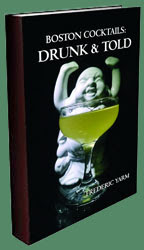 The final talk I attended at Tales of the Cocktail this year was given by a father-daughter duo, namely bartender Pamela Wiznitzer and her dad, autism specialist Dr. Max Wiznitzer. The talk was entitled "Brains & Booze: The Neurology of Mixology." While a lot of the talk was an overview of the brain and sensing organs, I will focus on the regions of overlap that are specific to cocktail appreciation.
The final talk I attended at Tales of the Cocktail this year was given by a father-daughter duo, namely bartender Pamela Wiznitzer and her dad, autism specialist Dr. Max Wiznitzer. The talk was entitled "Brains & Booze: The Neurology of Mixology." While a lot of the talk was an overview of the brain and sensing organs, I will focus on the regions of overlap that are specific to cocktail appreciation.Without the senses, people would just drink raw alcohol, but many things affect the enjoyment of a drink and these things change with age. One of the key parts of the brain that determines the enjoyment of a drink is the amygdala that determines the intensity of emotion -- not only whether it is pleasant or not, but what are the expectations given previous experiences. There is definitely an importance on having the experience being a positive one the first time through. Pleasant is the interconnection between the flavor cortex and the "pleasure centers." Here, smell turns out to be the most powerful tool, then taste, but touch also plays a role.
While the eyes, touch, and smell all play factors in enjoying a drink, the mouth deals a lot with texture, temperature, and taste. Texture can be to detect hazards like sharp or sandy object or beneficial like creaminess which implies that the foodstuff contains fat and nutrition. Temperature is like the three bears -- too hot can damage the cells, too cold and the tongue is numb and cannot taste, and just right. The taste aspect determines the nutrient value of food. Sweet implies energy rich food, salt suggests electrolytes necessary for balance, and umami is linked to amino acids and protein; science has found the intersection of these three components by creating the ultimate junk food, the Dorito. In addition, taste can suggest hazards like bitter meaning toxins, sour suggesting spoilage, and very salty implying too much mineral content or the wrong ones. An individual can get a palate for these hazards if there is a good association with the flavor.
In discussing the taste/olfactory cortex, the Martini and how it is garnished came up. A citrus peel garnish will add more fruity and floral accents whereas a briny olive will donate salt and umami notes. Indeed, different palates will gravitate to different Martini garnishes.
The doctor commented that we usually do not like brown liquids since they are often associated with fouled water and bodily functions; however, a child can quickly learn that chocolate milk is a good thing. In the realm of Tiki drinks where a lot of the drinks end up brown and murky, the bartender often serves them in opaque mugs. This helps to mask the perception of color when we first appreciate the drink. When I mentioned this fact to RumScout later, he replied that he did find the Jet Pilot served in a rocks glass to be a little startling and unsightly. In terms of creamy drinks like the Alexander, it may remind you of the chocolate milk that you had as a kid. You might not ask for one, but if it were put in front of you, you would drink it. And when an Alexander was passed to the crowd, most of them including mine did get finished.
With age, bitter and spice desires increase, and this is believed to be linked to the degradation of taste receptors. The same is true with salt and umami notes. Therefore, the average 21 year old might not like that Cynar drink the first time, but the 35 year old possibly will.
When Pamela developed the menu at Seamstress, she thought a lot about texture including sugar and fat content, binding agents like a pinch of salt, and the taste of citrus throughout the year. She was also careful not to put in too many flavors but to build off of the base spirits. Garnishes need to apply, but the nose does not need to match as contrast is effective too. She also reminded us that a bartender is not creating drinks for themselves but for a larger subset of the population. At Seamstress, all of the new drink ideas were made for the bartenders, owners, staff, and select clientele, and recipes only made the list if everyone in the room would drink the creation.
 The 2017 collection of 855 drink recipes, bartender tributes, and essays on hospitality from CocktailVirgin's Frederic Yarm. Available at
The 2017 collection of 855 drink recipes, bartender tributes, and essays on hospitality from CocktailVirgin's Frederic Yarm. Available at  The 2012 collection of 505 drink recipes, techniques, and Boston bar recommendations from Frederic Yarm. Available at
The 2012 collection of 505 drink recipes, techniques, and Boston bar recommendations from Frederic Yarm. Available at 




No comments:
Post a Comment